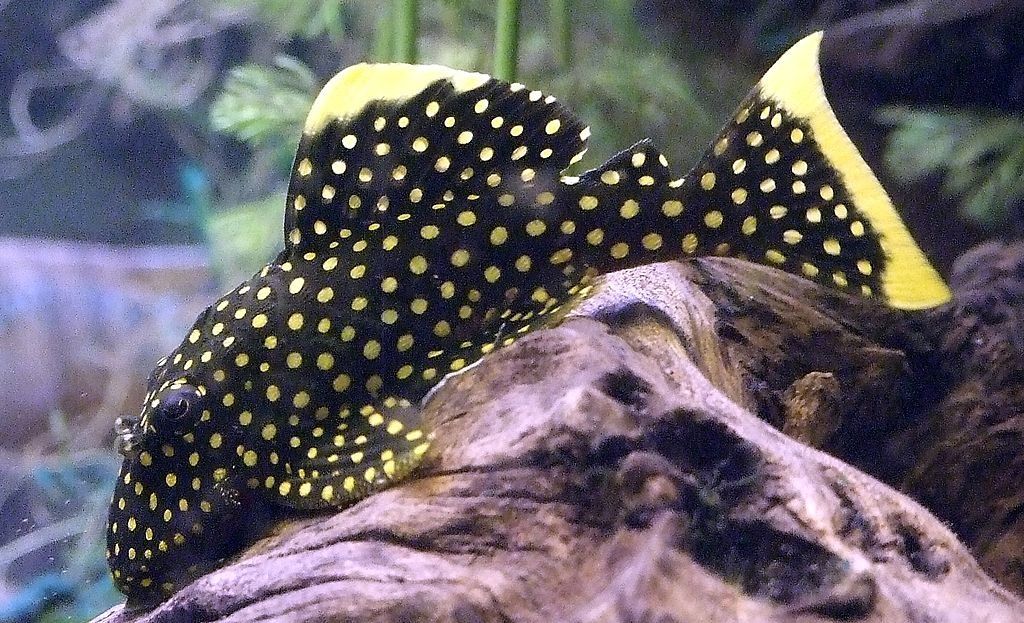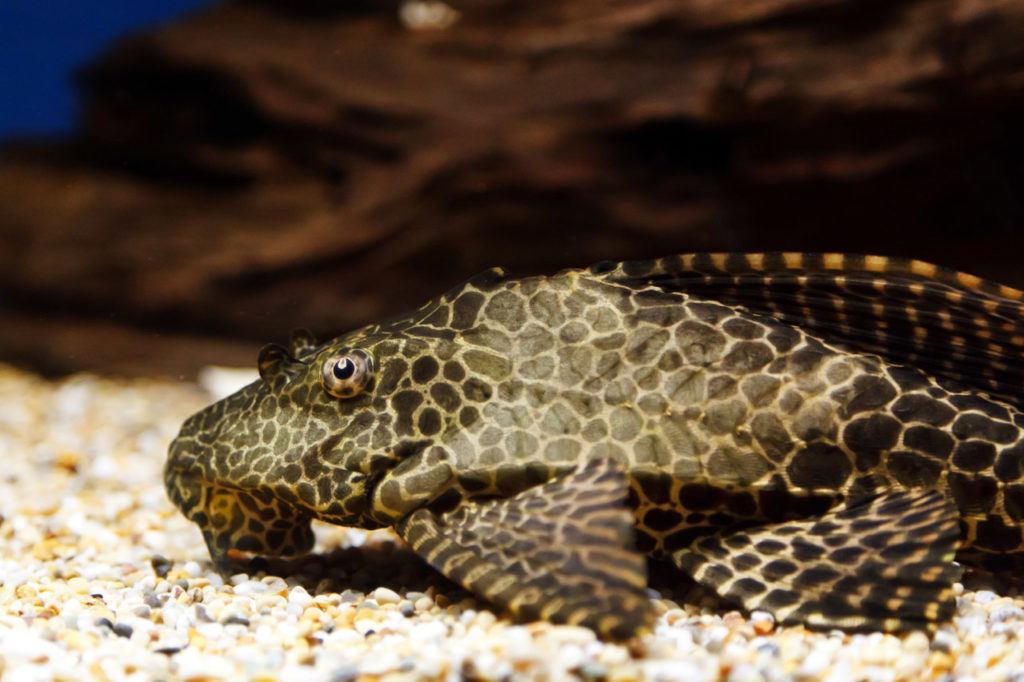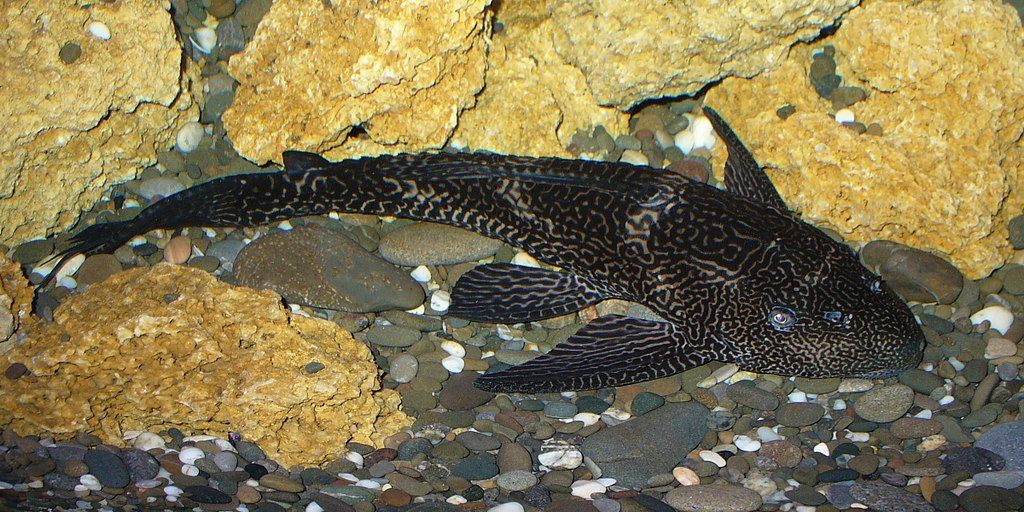What’s worse in a new fish tank than a layer of green, slimy algae over everything?
While there are plenty of ways to manage algae in the tank, from chemicals to elbow grease, you can help control it with a new addition to your tank too. How about a funny little cold water pleco fish?
What is a pleco fish? Let’s take a look at the popular little garbage disposals of aquarists.
Contents
Pleco Fish Basic Ins and Outs
Pleco Fish Appearance
Pleco is a name used for a variety of fish, but they are all catfish of the family Loricariidae. Because there are a variety of species sold commercially, you could end up with a fish that grows to anywhere from five inches to two feet long!
The most common varieties found in pet stores are the Sailfin Pleco, the Bristlenose Pleco, and the Suckermouth Pleco.
All of these may only be labelled in your pet store as a ‘Common Pleco,’ and they are all typically sold at three inches in length.
These fish are found in the wild in the fresh waters of Central and South America and are opportunistic eaters. They are primarily nocturnal, so don’t be surprised if you don’t see them active much during the day.

They are a hardy and long-lived fish, some living for 20-30 years in captivity – which is a considerable amount of time for fish!
Most Plecos come in varying shades of gray or brown for camouflage when they hang out on rocks or driftwood during the day.
They have a specially-designed mouth that helps them attach to objects—including the side of your tank—and slurp up whatever food they can find.
Pleco Fish Care
Tank Requirements
Since there are so many species of plecos available, the tank size will vary by species.
Most plecos are sold in pet stores at only a few inches long, so you can start them in smaller tanks, but be aware an upgrade may be necessary in the future.
The best rule of thumb is that each inch of fish should have ten gallons of water, so keep an eye on how big they are getting. The good news is, if your fish outgrows your tank, many pet stores will buy your fish back, as they can then sell it to another buyer.
Plecos like to have plenty of places to hide during the day. A tunnel or rock should suit them fine, but they especially love driftwood to attach to, as some species will need to chew on it for their daily intake of fiber.
These fish can jump, too, so make sure your tank has a secure lid. Because of their sucker-like mouth, they may scratch acrylic tank sides, so they do better with glass.
These fish are not picky when it comes to substrate. They do just as well with a bare-bottomed tank as they do sand or gravel, so it’s really up to your choice of aesthetic. As long as they have places to hide, they are content to cruise for food all night long.
Because these fish are nocturnal, they are equipped to feed during darker conditions.
They actually have a special membrane over their eyes to protect them when it is bright out, so make sure that you turn your aquarium light off at night – as close to a normal dawn/dusk cycle as possible – to make sure your pleco has plenty of time to search for food.
If you want to encourage them to be more active during the day, dim your aquarium lights and include some floating plants for them to hide in.
Water Quality
As with all fish tanks, the water, substrate, and decorations should be cycled in the tank before fish are introduced.
Because they hail from Central and South America, they prefer a tank kept between 73-81° F, but they will also be fine in cooler temperatures. Bristlenose Plecos especially are fine in temperatures as low as 60° F.
The pH in your tank should be in the range of 5.5-7.6. Because these fish are so versatile, you have the flexibility to set your tank to the best standards of your other fish, and your pleco should adapt just fine.
Introducing Them to the Tank
If you already have fish in your tank and want to add a pleco, the best way to do so is in a quarantine tank first. This not only keeps a potentially sick fish away from the others, but it allows the new fish to get used to the water and food you are providing, reducing stress.
Before you remove your pleco from quarantine, make sure that the tank has plenty of places for the pleco to hide.
Rearrange the current layout of your tank to distract the existing fish and remove any established territories.
Feed your current fish right before introducing the new one, which will make them less aggressive. It is also better to introduce more than one new fish at once, as it reduces the chances of one new fish being singled out and aggravated.
And, as always, make sure you water is clean and appropriately balanced to reduce stress in all of the fish.
Maintaining the Tank
Once a tank is set up and the fish are happy, water changes are the best way to maintain a healthy tank.
Smaller tanks require more frequent water changes because toxins such as ammonia and nitrates build up more quickly compared to larger tanks.
Regular water changes and good filters are more important the smaller the tank. Once a week, take out the filter and clean it, and change the water at least once a month.
Replace 10-25% of the tank’s water each month, and make sure you check the temperature and pH afterwards to maintain your healthy environment.
Pleco Fish Food
These fish are truly the garbage disposals of the fish world. They are opportunistic omnivores, which means they will eat just about anything they can get into their mouths.
They primarily eat algae, so be sure to supplement their diet of naturally-occurring algae with algae pellets. These pellets are best dropped just before you turn off the lights, as the pleco is nocturnal, but this will also dissuade your other fish from eating the pellet before your pleco can get to it.
Plecos also love to eat live plants, so be aware if you keep any in your tank that you will have to periodically replace.Give your pleco a special treat by anchoring a piece of zucchini or lettuce to the bottom and letting them munch away.
You can also feed them some meatier bits like cichlid pellets, and they are happy to scavenge whatever fish food falls to the bottom uneaten from its tankmates. This will also help reduce your tank’s nitrate, as the pleco will eat fallen food before it has a chance to rot.
You should notice a cleaner tank within a few weeks of owning your pleco, though they do not eat feces, so water and substrate changes are still necessary for fish health.
Pleco Fish Tankmates
Do plecos eat other fish? A lot of times they get blamed for dead fish, as in the morning you may walk over and see them munching on a dead fish at the bottom of the tank. This is really because they are opportunistic omnivores, and they simply saw a food source.
Plecos fish are not aggressive towards other species, though it is best to only keep one pleco in a tank at a time, as they can get territorial towards the same species.Otherwise, they are good with just about any species of fish.
Just be careful with very flat-sided fish, as a pleco may attach to the side of it and accidentally injure the fish. Other fish tend to leave them alone, as they typically hang out on the bottom and hide during the day.
Only very aggressive species may bother them, but some species of pleco have an armored top or even spiked fins, and that’s usually enough for them to be left alone.
Occasionally, old plecos will get very territorial and may become aggressive towards other fish. If this happens, simply remove them to their own tank to avoid stress and injury, and move a young pleco into your primary tank to continue your algae control.
Health Concerns
Disease can be introduced into the tank when you add anything that has not been properly cleaned or quarantined, including live rock, plants, and fish.
The best prevention is proper care and the cleaning of anything new going into the tank, as well as making sure that you provide quality food, good water, and proper tankmates.
Two common health problems for fresh water fish are cloudy eye and ich. Cloudy eye is when the fish’s eyes are covered with a white or gray slime, and the fish may appear off-color and swim awkwardly.
This is usually an issue of water quality, but the fish should be quarantined. Ich is usually seen with white spots on the fins and body and can be treated easily. Quarantine the fish immediately, and then treat with a commercial ich remedy for at least two weeks.
Here’s a video showing how to care for your pleco fish.
Plecos are very hardy fish and rarely get ill, as long as their tank is kept clean and they have all of their environmental needs met.
They are a funny and useful fish to keep in your tank and get along with almost any kind of fish. Perfect for beginners, these fish could soon be your favorite little garbage disposals overall.
Do you own any pleco fish?





